Protecting Rural Large Old Trees with Multi-Scale Strategies: Integrating Spatial Analysis and the Contingent Valuation Method (CVM) for Socio-Cultural Value Assessment
Abstract
:1. Introduction
2. Materials and Methods
2.1. Study Area
2.2. Data Collection
2.2.1. The Census Data
2.2.2. Questionnaire Survey
2.3. Statistical and Spatial Analysis of the Scattered Large Old Trees
2.4. Contingent Valuation and Driving Factor Analysis
2.5. Multi-Scale Socio-Cultural Value Assessment
3. Results
3.1. Community Characteristics and Spatial Distribution of the Scattered Large Old Trees in the Study Area
3.1.1. Community Characteristics
3.1.2. Spatial Distribution
3.2. Socio-Cultural Valuation of the Scattered Large Old Trees by Local Residents and a Driving Factors Analysis
3.2.1. The Average WTP of Respondents for the Socio-Cultural Value of Scattered Large Old Trees
3.2.2. Factors Determining Local Residents’ WTP for the Socio-Cultural Value of Scattered Large Old Trees
3.3. Socio-Cultural Value Mapping of Scattered Large Old Trees at Different Scales
4. Discussion
4.1. Rural Large Old Tree Protection Is Faced with More Challenges
4.2. Socio-Cultural Valuation of Rural Large Old Trees and Driving Factors
4.3. Implications for Rural Large Old Trees’ Protection with Multi-Scale Strategies
5. Conclusions
Supplementary Materials
Author Contributions
Funding
Data Availability Statement
Acknowledgments
Conflicts of Interest
References
- Cannon, C.H.; Piovesan, G.; Munné-Bosch, S. Old and ancient trees are life history lottery winners and vital evolutionary resources for long-term adaptive capacity. Nat. Plants 2022, 8, 136–145. [Google Scholar] [CrossRef] [PubMed]
- Gilhen-Baker, M.; Roviello, V.; Beresford-Kroeger, D.; Roviello, G.N. Old growth forests and large old trees as critical or-ganisms connecting ecosystems and human health. A review. Environ. Chem. Lett. 2022, 20, 1529–1538. [Google Scholar] [CrossRef] [PubMed]
- Jones, G.M.; Keane, J.J.; Gutiérrez, R.J.; Peery, M.Z. Declining old-forest species as a legacy of large trees lost. Divers. Distrib. 2018, 24, 341–351. [Google Scholar] [CrossRef]
- Piovesan, G.; Cannon, C.H.; Liu, J.; Munné-Bosch, S. Ancient trees: Irreplaceable conservation resource for ecosystem restoration. Trends Ecol. Evol. 2022, 37, 1025–1028. [Google Scholar] [CrossRef] [PubMed]
- Lindenmayer, D.B.; Laurance, W.F.; Franklin, J.F. Global Decline in Large Old Trees. Science 2012, 338, 1305–1306. [Google Scholar] [CrossRef] [PubMed]
- Lindenmayer, D.B. Conserving large old trees as small natural features. Biol. Conserv. 2017, 211, 51–59. [Google Scholar] [CrossRef]
- Liu, J.; Lindenmayer, D.B.; Yang, W.; Ren, Y.; Campbell, M.J.; Wu, C.; Luo, Y.; Zhong, L.; Yu, M. Diversity and density patterns of large old trees in China. Sci. Total Environ. 2019, 655, 255–262. [Google Scholar] [CrossRef]
- Zhang, X.; Wang, L.; Liu, Z.; Zheng, T.; Cao, Y.; Liu, X. The current situation and countermeasures for conservation of ancient and famous trees in Laoshan, Qingdao, China. Ciência Rural 2019, 49, 1–13. [Google Scholar] [CrossRef]
- Lindenmayer, D.B.; Laurance, W.F. The Unique Challenges of Conserving Large Old Trees. Trends Ecol. Evol. 2016, 31, 416–418. [Google Scholar] [CrossRef]
- Lindenmayer, D.B.; Laurance, W.F. The ecology, distribution, conservation and management of large old trees. Biol. Rev. 2017, 92, 1434–1458. [Google Scholar] [CrossRef]
- Lu, Z.; Zhu, L.; Lu, J.; Shen, N.; Wang, L.; Liu, S.; Wang, Q.; Yu, W.; Kato-Noguchi, H.; Li, W.; et al. Rejuvenation in-creases leaf biomass and flavonoid accumulation in Ginkgo biloba. Hortic. Res. 2022, 9, uhab018. [Google Scholar] [CrossRef] [PubMed]
- Liu, J.; Xia, S.; Zeng, D.; Liu, C.; Li, Y.; Yang, W.; Yang, B.; Zhang, J.; Slik, F.; Lindenmayer, D.B. Age and spatial distribution of the world’s oldest trees. Conserv. Biol. 2022, 36, e13907. [Google Scholar] [CrossRef] [PubMed]
- Huang, L.; Jin, C.; Zhen, M.; Zhou, L.; Qian, S.; Jim, C.Y.; Lin, D.; Zhao, L.; Minor, J.; Coggins, C.; et al. Biogeographic and anthropogenic factors shaping the distribution and species assemblage of heritage trees in China. Urban For. Urban. Green. 2020, 50, 126652. [Google Scholar] [CrossRef]
- Hou, H.; Zhang, L.; Bi, H.; He, J.; Cai, E.; Ren, W. Differential characteristics and driving forces of the spatial distribution of heritage trees in Luoyang, an ancient capital of China. Front. Environ. Sci. 2022, 10, 993333. [Google Scholar] [CrossRef]
- Zhang, H.; Lai, P.Y.; Jim, C.Y. Species diversity and spatial pattern of old and precious trees in Macau. Landsc. Urban. Plan. 2017, 162, 56–67. [Google Scholar] [CrossRef]
- Yin, L. Resources Investigation and Characteristic Analysis of Ancient and Famous Trees in Meiling National Forest Park, Jiangxi Province. Master’s Thesis, Jiangxi Agricultural University, Nanchang, China, 2019; p. 73. (In Chinese). [Google Scholar]
- Huang, L.; Tian, L.; Zhou, L.; Jin, C.; Qian, S.; Jim, C.Y.; Lin, D.; Zhao, L.; Minor, J.; Coggins, C.; et al. Local cultural beliefs and practices promote conservation of large old trees in an ethnic minority region in southwestern China. Urban For. Urban. Green. 2020, 49, 126584. [Google Scholar] [CrossRef]
- Lijuan, T. The Composition and Characteristics of Heritage Trees in Ethnic Minority Areas in Southwest China: A Case Study of Guizhou Wuchuan Gelao and Miao Ethnic Autonomous County. Master’s Thesis, Chongqing University, Chongqing, China, 2018. (In Chinese). [Google Scholar]
- Orłowski, G.; Nowak, L. The importance of marginal habitats for the conservation of old trees in agricultural landscapes. Landsc. Urban. Plan. 2007, 79, 77–83. [Google Scholar] [CrossRef]
- Qiu, Z.; Hu, X.; Qian, H.; Wei, B.; Liao, K. Analysis of spatial distribution characteristics of ancient and famous trees in Xintian County. J. Cent. South Univ. For. Technol. 2022, 42, 1–11. (In Chinese) [Google Scholar]
- Fu, Q.; Qiu, E.; Zhang, Y.; Huang, L.; Wang, H.; Jiang, S. Discussion of the Distribution Pattern and Driving Factors of Large Old Tree Resources in Beijing. Forests 2022, 13, 1500. [Google Scholar] [CrossRef]
- Blicharska, M.; Mikusinski, G. Old Trees: Cultural Value. Science 2013, 339, 904. [Google Scholar] [CrossRef]
- Blicharska, M.; Mikusiński, G. Incorporating Social and Cultural Significance of Large Old Trees in Conservation Policy. Conserv. Biol. 2014, 28, 1558–1567. [Google Scholar] [CrossRef] [PubMed]
- Breyne, J.; Dufrêne, M.; Maréchal, K. How integrating ‘socio-cultural values’ into ecosystem services evaluations can give meaning to value indicators. Ecosyst. Serv. 2021, 49, 101278. [Google Scholar] [CrossRef]
- Reid, W.V.; Mooney, H.A.; Cropper, A.; Capistrano, D.; Carpenter, S.R.; Chopra, K.; Dasgupta, P.; Dietz, T.; Duraiappah, A.K.; Hassan, R. Ecosystems and Human Well-Being-Synthesis: A Report of the Millennium Ecosystem Assessment; Island Press: Washington, DC, USA, 2005. [Google Scholar]
- Chen, J.; Lin, W.; Zhang, Y.; Dai, Y.; Chen, B. Village Fengshui Forests as Forms of Cultural and Ecological Heritage: Interpretations and Conservation Policy Implications from Southern China. Forests 2020, 11, 1286. [Google Scholar] [CrossRef]
- Subrat Sharma, H.C.R.L. Conservation of Natural Resources Through Religion: A Case Study from Central Himalaya. Soc. Nat. Resour. 1999, 12, 599–612. [Google Scholar] [CrossRef]
- Venkatachalam, L. The contingent valuation method: A review. Environ. Impact Assess. Rev. 2004, 24, 89–124. [Google Scholar] [CrossRef]
- Vo, N.X.; Huyen Nguyen, T.T.; Van Nguyen, P.; Tran, Q.V.; Vo, T.Q. Using contingent valuation method to estimate adults’ willingness to pay for a future coronavirus 2019 vaccination. Value Health Reg. Issues 2021, 24, 240–246. [Google Scholar] [CrossRef] [PubMed]
- Chen, W.Y. Public willingness-to-pay for conserving urban heritage trees in Guangzhou, south China. Urban For. Urban. Green. 2015, 14, 796–805. [Google Scholar] [CrossRef]
- Lin, H.; Chuang, Y.; Liu, W. Assessing the economic value of an iconic urban heritage tree. Forest Policy Econ. 2020, 118, 102216. [Google Scholar] [CrossRef]
- Son, H.; Xia, T.; Kim, Y.; Kang, T. A Value Evaluation Research of the Old-growth and Giant Tree—Focus on Gyeongju Gyerim’s Zelkova Serrata. J. Korean Inst. Tradit. Landsc. Archit. 2016, 34, 51–56. [Google Scholar] [CrossRef]
- Wang, B.; Xiu, X.; Lan, S. Monetary Valuation of the Cultural Value of Ancient and Famous Trees. Issues For. Econ. 2016, 36, 565–570. (In Chinese) [Google Scholar]
- Wang, J.; Yu, F.; Ma, G.; Peng, F.; Zhou, X.; Wu, C.; Yang, W.; Wang, C.; Cao, D.; Jiang, H.; et al. Gross economic-ecological product as an integrated measure for ecological service and economic products. Resour. Conserv. Recycl. 2021, 171, 105566. [Google Scholar] [CrossRef]
- Yang, H.; Gou, X.; Ma, W.; Xue, B. Research and application of GEP: China’ s experience in natural capital accounting. Front. Environ. Sci. 2023, 11, 75. [Google Scholar] [CrossRef]
- Hartel, T.; Réti, K.; Craioveanu, C. Valuing scattered trees from wood-pastures by farmers in a traditional rural region of Eastern Europe. Agric. Ecosyst. Environ. 2017, 236, 304–311. [Google Scholar] [CrossRef]
- Yamin, Z. The results of the second national survey of ancient and famous tree resources were announced. Land. Green. 2022, 9, 16–17. (In Chinese) [Google Scholar]
- Baoding Bureau Of Statistics. Baoding Economy Statistical Yearbook; China Statistics Press: Beijing, China, 2020. [Google Scholar]
- Wu, J. The Supernova Remnant of More than 4100 Years Ago Was Discovered—Emperor Yao’s Jingxing (PKS 1209-52). Chin. Astron. Astrophys. 2023, 47, 309–334. [Google Scholar]
- Lu, P.; Li, M.; Fu, S.; Henrietta Onyebuchi, C.; Zhang, Z. Modeling the warring states period: History dynamics of initial unified empire in China (475 BC to 221 BC). Expert Syst. Appl. 2023, 230, 120560. [Google Scholar] [CrossRef]
- Li, K.; Zhang, G. Species Diversity and Distribution Pattern of Heritage Trees in the Rapidly-Urbanizing Province of Jiangsu, China. Forests 2021, 12, 1543. [Google Scholar] [CrossRef]
- Yang, J.; Huang, X. The 30 m annual land cover dataset and its dynamics in China from 1990 to 2019. Earth Syst. Sci. Data 2021, 13, 3907–3925. [Google Scholar] [CrossRef]
- Zhu, H.; Li, Y.; Liu, Z.; Fu, B. Estimating the population distribution in a county area in China based on impervious surfaces. Photogramm. Eng. Remote Sens. 2015, 81, 155–163. [Google Scholar] [CrossRef]
- Chen, B.; Coggins, C.; Minor, J.; Zhang, Y. Fengshui forests and village landscapes in China: Geographic extent, socioecological significance, and conservation prospects. Urban For. Urban. Green. 2018, 31, 79–92. [Google Scholar] [CrossRef]
- Wang, X.; Fan, B.; Li, Z.; Song, J.; Liu, S.; Chen, L.; Cai, D.; Yin, G.; Jiang, Z. Forest cultural value evaluation index system and methodology. Acta Ecol. Sin. 2021, 41, 202–212. (In Chinese) [Google Scholar]
- Wan, C.; Shen, G.Q.; Choi, S. Underlying relationships between public urban green spaces and social cohesion: A systematic literature review. City Cult. Soc. 2021, 24, 100383. [Google Scholar] [CrossRef]
- Zhao, P.; Ren, Z. Distribution and cultural value of old tree resources in Xinzhou city. J. Arid. Land. Resour. Environ. 2023, 37, 150–156. (In Chinese) [Google Scholar]
- Hartl, C.; St. George, S.; Konter, O.; Harr, L.; Scholz, D.; Kirchhefer, A.; Esper, J. Warfare dendrochronology: Trees witness the deployment of the German battleship Tirpitz in Norway. Anthropocene 2019, 27, 100212. [Google Scholar] [CrossRef]
- Senetra, A. Forests as an important spatial element in elaboration of the esthetic value maps for rural landscapes. Sylwan 2015, 159, 757–766. [Google Scholar]
- Qian, H. Large-scale biogeographic patterns of vascular plant richness in North America: An analysis at the generic level. J. Biogeogr. 1998, 25, 829–836. [Google Scholar] [CrossRef]
- Simon, J.S. Density Estimation. Stat. Sci. 2004, 19, 588–597. [Google Scholar]
- Guo, L.; Cheng, S.; Liu, J.; Wang, Y.; Cai, Y.; Hong, X. Does social perception data express the spatio-temporal pattern of perceived urban noise? A case study based on 3,137 noise complaints in Fuzhou, China. Appl. Acoust. 2022, 201, 109129. [Google Scholar]
- Wang, Z.; Smyth, R. A hybrid method for creating Lorenz curves. Econ. Lett. 2015, 133, 59–63. [Google Scholar] [CrossRef]
- Yang, Y.; Bao, G.; Zhang, D.; Zhai, C. Spatial Distribution and Driving Factors of Old and Notable Trees in a Fast-Developing City, Northeast China. Sustainability 2022, 14, 7937. [Google Scholar] [CrossRef]
- Lai, P.Y.; Jim, C.Y.; Da Tang, G.; Hong, W.J.; Zhang, H. Spatial differentiation of heritage trees in the rapidly-urbanizing city of Shenzhen, China. Landsc. Urban. Plan. 2019, 181, 148–156. [Google Scholar] [CrossRef]
- Grilli, L.; Rampichini, C. Ordered Logit Model. In Encyclopedia of Quality of Life and Well-Being Research; Maggino F, Ed.; Springer International Publishing: Cham, Switzerland, 2020; pp. 1–4. [Google Scholar]
- Bellizzi, M.G.; Eboli, L.; Forciniti, C.; Mazzulla, G. Air Transport Passengers’ Satisfaction: An Ordered Logit Model. Transp. Res. Procedia 2018, 33, 147–154. [Google Scholar] [CrossRef]
- Piedra-Bonilla, E.B.; Da Cunha, D.A.; Braga, M.J. Climate variability and crop diversification in Brazil: An ordered probit analysis. J. Clean. Prod. 2020, 256, 120252. [Google Scholar] [CrossRef]
- Liu, W.; Chuang, Y. To exclude or not to exclude? The effect of protest responses on the economic value of an iconic urban heritage tree. Urban. For. Urban. Green. 2022, 71, 127551. [Google Scholar] [CrossRef]
- Levantesi, S.; Piscopo, G. The Importance of Economic Variables on London Real Estate Market: A Random Forest Approach. Risks 2020, 8, 112. [Google Scholar] [CrossRef]
- Rhodes, J.S.; Cutler, A.; Moon, K.R. Geometry- and Accuracy-Preserving Random Forest Proximities. IEEE Trans. Pattern Anal. Mach. Intell. 2023, 45, 10947–10959. [Google Scholar] [CrossRef] [PubMed]
- Nachouki, M.; Mohamed, E.A.; Mehdi, R.; Abou Naaj, M. Student course grade prediction using the random forest algorithm: Analysis of predictors’ importance. Trends Neurosci. Educ. 2023, 33, 100214. [Google Scholar] [CrossRef] [PubMed]
- Wang, B. Study on Cultural Value of the Ancient and Famous Tree in China. Master’s Thesis, Nanjing Agricultural University, Nanjing, China, 2009; p. 94. (In Chinese). [Google Scholar]
- Wang, Q.; Zhou, X.; Huo, Z.; Shi, L.; Zhang, Y. Building an Up-and-Coming City-An overview of the Geological Data Sharing Service Platform of the Xiongan New Area. China Geol. 2019, 3, 566–568. [Google Scholar] [CrossRef]
- Lu, H. Characteristics of the ancient and famous tree resources in Hebei Province and conservation strategies. Hebei For. 2012, 7, 20–21. (In Chinese) [Google Scholar]
- Jianhua, X.; Cheng, L.; Congcong, L.; Ying, T.; Danmiao, Z. Study on the Resource Characteristics and Spatial Distribution of Ancient and Famous Trees: Taking the Tonglu County of Zhejiang Province as an Example. Nat. Prot. Areas 2022, 2, 110–118. (In Chinese) [Google Scholar]
- Bourne, K.S.; Conway, T.M. The influence of land use type and municipal context on urban tree species diversity. Urban. Ecosyst. 2014, 17, 329–348. [Google Scholar] [CrossRef]
- Huang, L.; Jin, C.; Pan, Y.; Zhou, L.; Hu, S.; Guo, Y.; Meng, Y.; Song, K.; Pang, M.; Li, H.; et al. Human activities and species biological traits drive the long-term persistence of old trees in human-dominated landscapes. Nat. Plants 2023, 9, 898–907. [Google Scholar] [CrossRef] [PubMed]
- Jim, C.Y.; Zhang, H. Species diversity and spatial differentiation of old-valuable trees in urban Hong Kong. Urban. For. Urban. Green. 2013, 12, 171–182. [Google Scholar] [CrossRef]
- Xu, F.; Wang, Y.; Xiang, N.; Tian, J.; Chen, L. Uncovering the willingness-to-pay for urban green space conservation: A survey of the capital area in China. Resour. Conserv. Recycl. 2020, 162, 105053. [Google Scholar] [CrossRef]
- Houkai, W.; Peng, Y.; Shukun, W. China Rural Revitalization Survey (2021); China Social Sciences Press: Beijing, China, 2022. [Google Scholar]
- Hartel, T.; Nita, A.; Rozylowicz, L. Understanding human-nature connections through value networks: The case of ancient wood-pastures of Central Romania. Sustain. Sci. 2020, 15, 1357–1367. [Google Scholar] [CrossRef]
- Majumdar, S.; Deng, J.; Zhang, Y.; Pierskalla, C. Using contingent valuation to estimate the willingness of tourists to pay for urban forests: A study in Savannah, Georgia. Urban For. Urban. Green. 2011, 10, 275–280. [Google Scholar] [CrossRef]
- Yu, Y.; Minghua, T.; Guowei, Q.; Zhenyu, Z.; Chunhui, L. Monetization evaluation on the comprehensive value of old and valuable trees in cities—A case study of “Marguis of Shade” in Beijing. J. Arid. Land. Resour. Environ. 2019, 33, 185–191. (In Chinese) [Google Scholar]
- DB11/T 767-2010; Specification for Routine Maintenance and Management of Ancient & Famous Woody Plants. Quality and Technical Supervision Bureau: Beijing, China, 2011.
- Li, S.; Chen, Z.; Guo, L.; Hu, F.; Huang, Y.; Wu, D.; Wu, Z.; Hong, X. How Do Spatial Forms Influence Psychophysical Drivers in a Campus City Community Life Circle? Sustainability 2023, 15, 10014. [Google Scholar] [CrossRef]
- The National Bureau of Development and Reform; the National Bureau of Statistics. Standard for the Gross Ecological Product Value Accounting; People’s Publishing House: Beijing, China, 2022. [Google Scholar]
- Hong, X.; Cheng, S.; Liu, J.; Guo, L.; Dang, E.; Wang, J.; Cheng, Y. How Should Soundscape Optimization from Perceived Soundscape Elements in Urban Forests by the Riverside Be Performed? Land 2023, 12, 1929. [Google Scholar] [CrossRef]
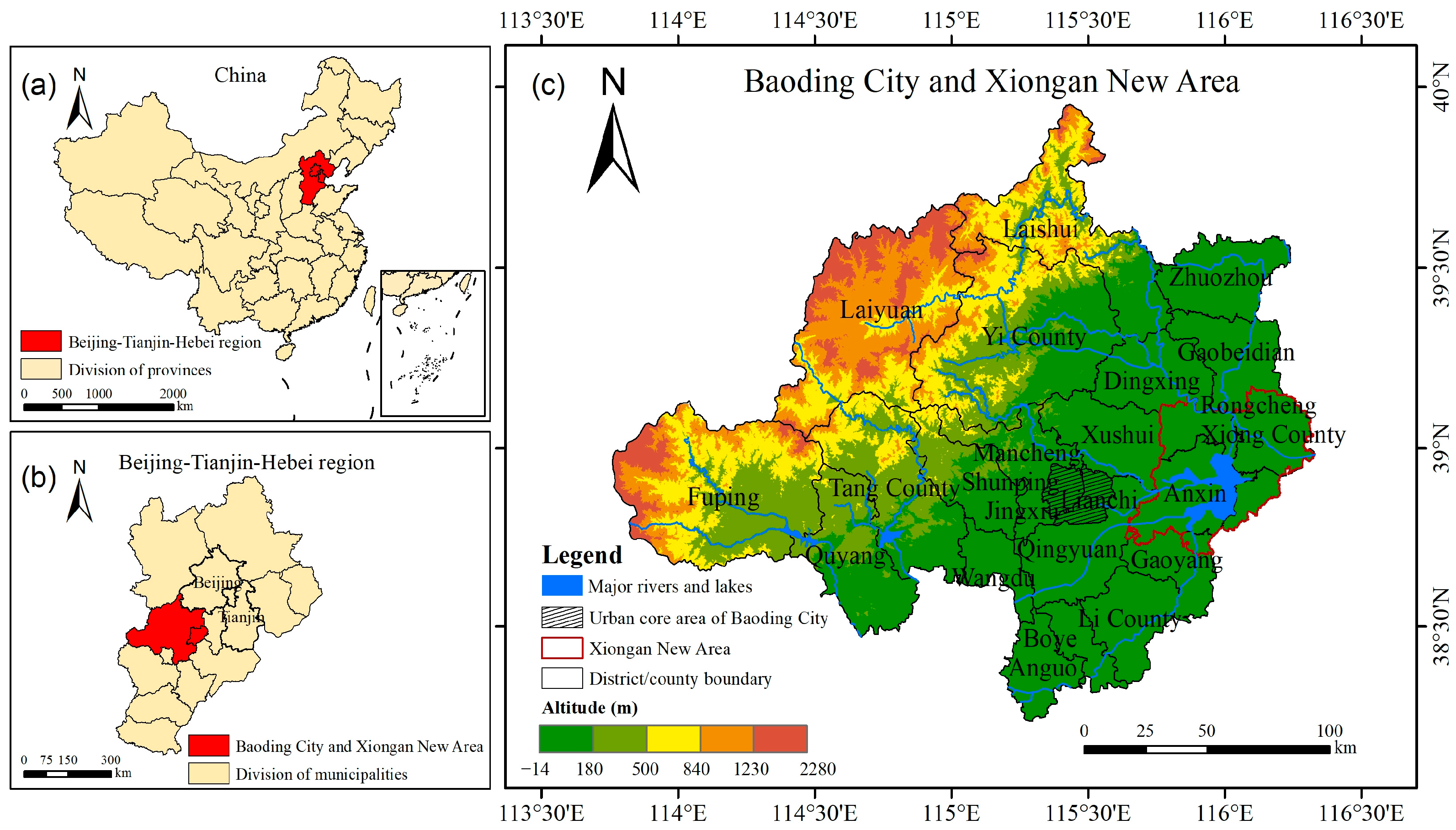

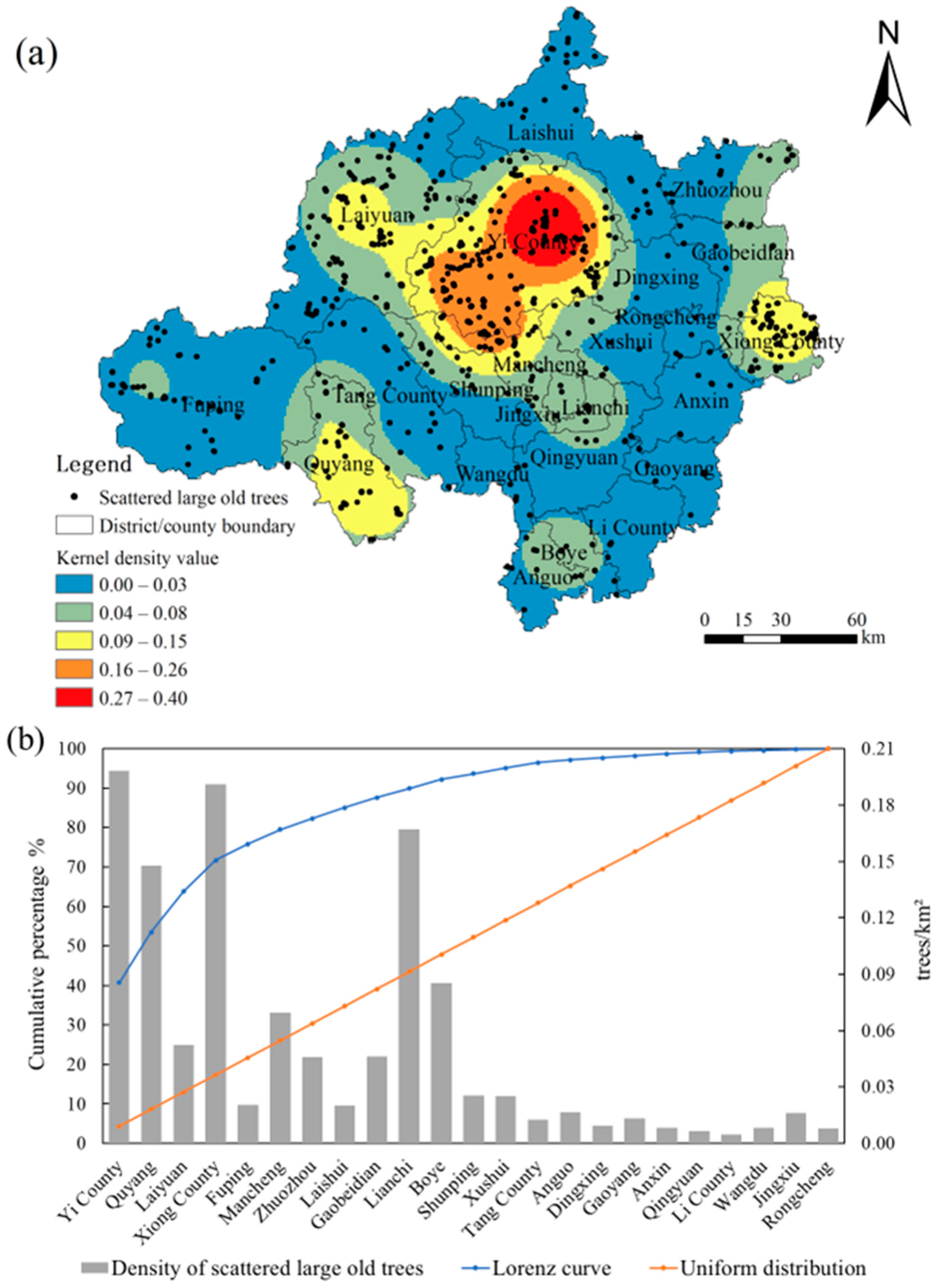
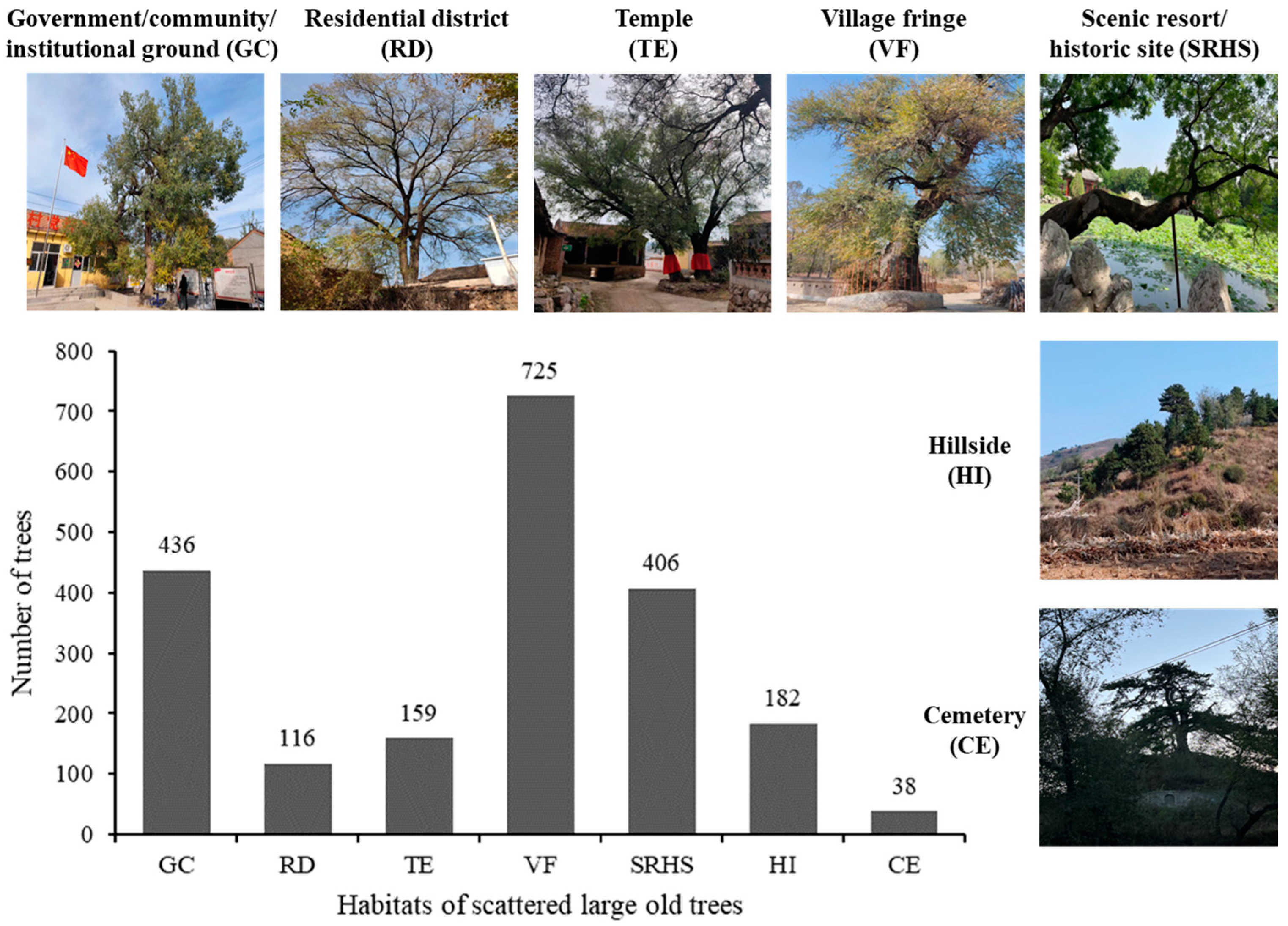

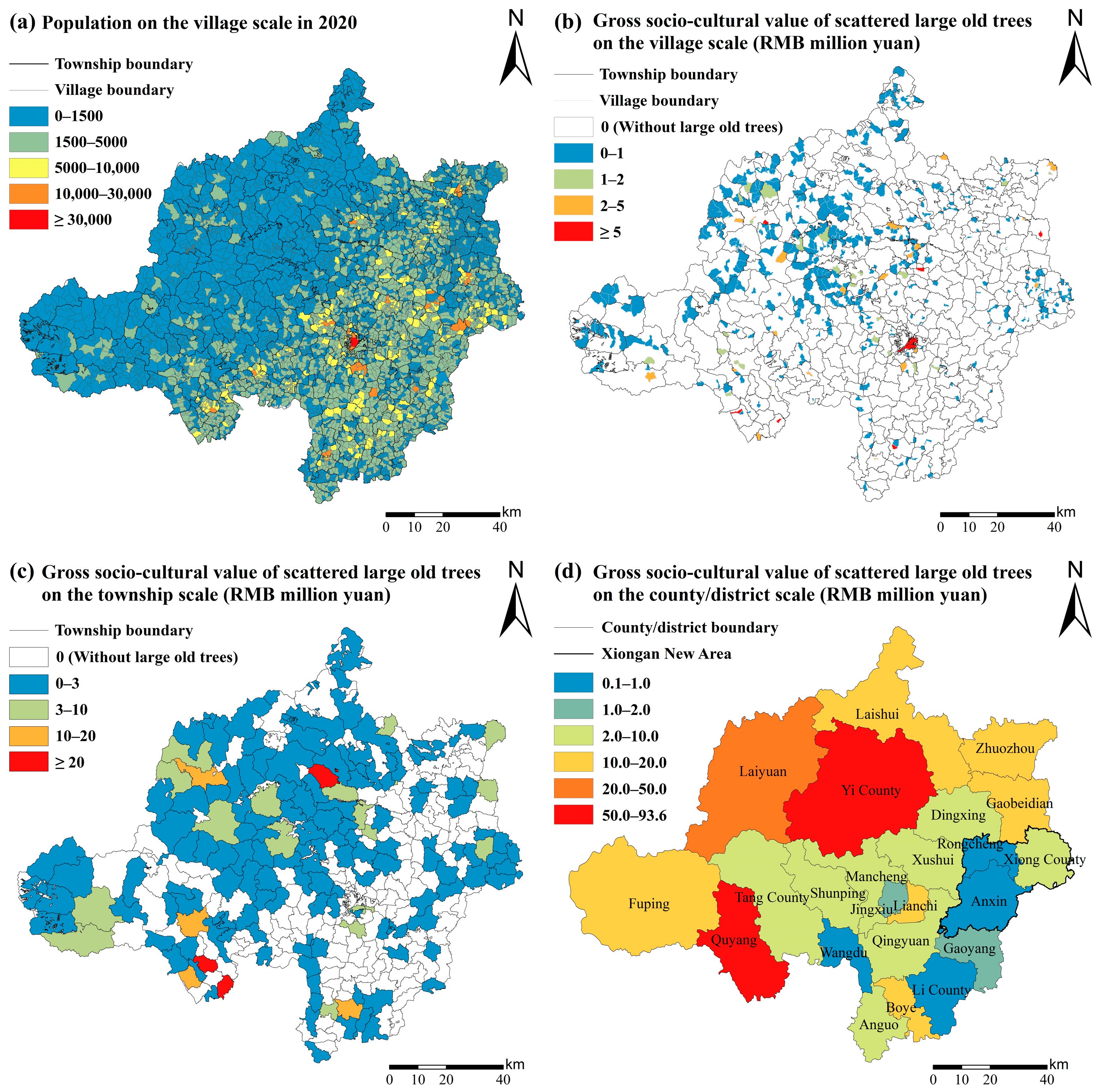
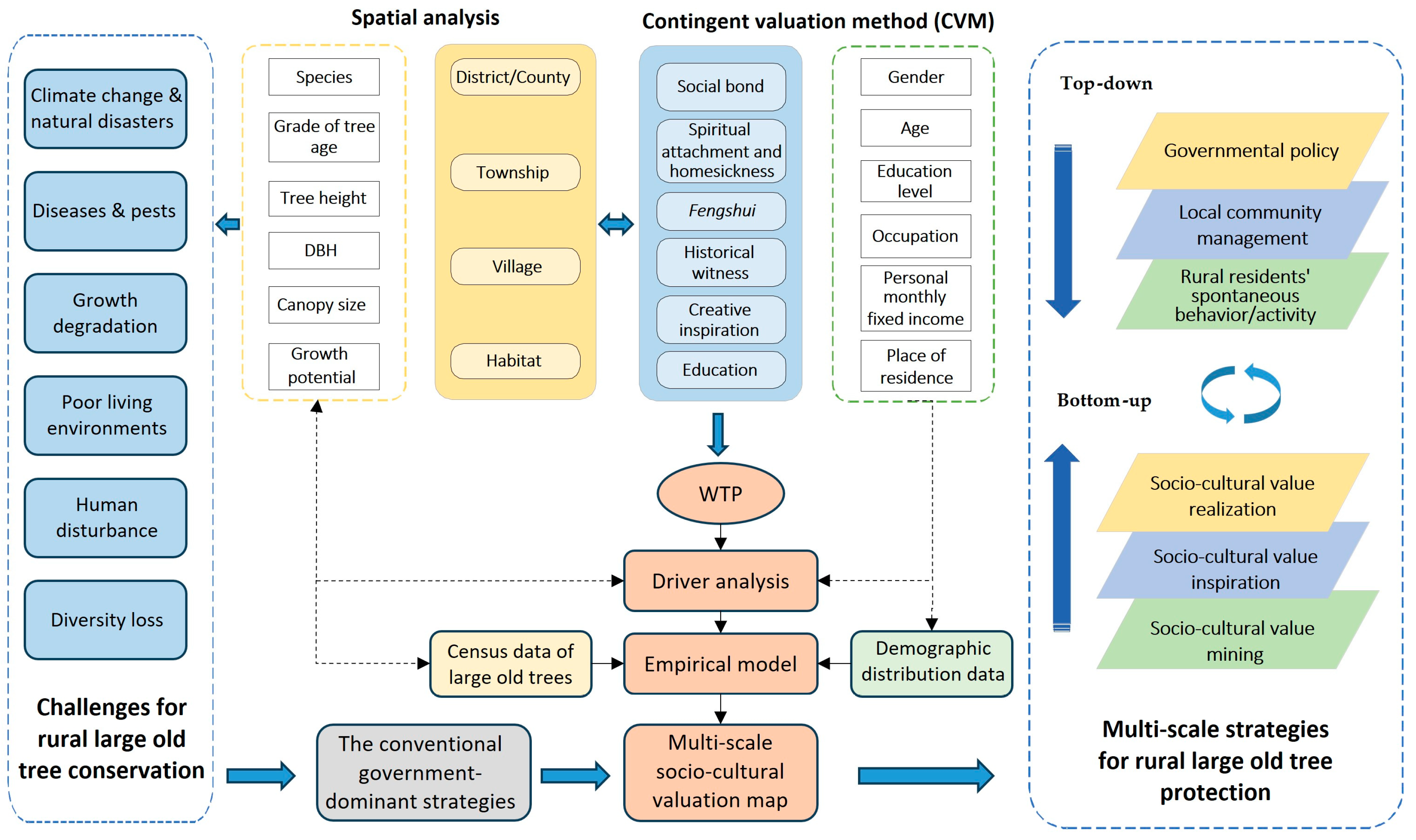
| Classification | Connotations |
|---|---|
| Social bond | The large old trees can facilitate social bonds by providing a place or landmark to get together, enjoy shade, and communicate [46]. |
| Spiritual attachment and homesickness | The large old trees can witness the growth of generations and protect them like divinities, bringing spiritual attachment and nostalgia to people who leave their hometown [47]. |
| Fengshui | The large old trees bear “fengshui” symbolism, which has the symbolic meanings of health, longevity, blessings and good fortune [44]. |
| Witnessing history | The large old trees are “living relics” that have witnessed the local history, and there are some historical stories associated with them [48]. |
| Creative inspiration | The large old trees can bring cultural creativity or inspiration that can appeal to our aesthetic sentiments, for example, drawing, photographing, and short video creation on social media, etc. [49]. |
| Education | The large old trees can be used as a good subject for conducting scientific research, popular science activities, or liberal education [22]. |
| Rank | Family | Number of Genera | Number of Species | Number of Trees | Percentage of Trees (%) |
|---|---|---|---|---|---|
| 1 | Pinaceae | 2 | 4 | 461 | 22.36 |
| 2 | Cupressaceae | 3 | 4 | 298 | 14.45 |
| 3 | Papilionaceae | 1 | 1 | 293 | 14.21 |
| 4 | Ebenaceae | 1 | 2 | 256 | 12.42 |
| 5 | Rhamnaceae | 1 | 2 | 231 | 11.20 |
| 6 | Rosaceae | 3 | 5 | 215 | 10.43 |
| 7 | Fagaceae | 2 | 5 | 99 | 4.80 |
| 8 | Salicaceae | 2 | 5 | 42 | 2.04 |
| 9 | Anacardiaceae | 1 | 1 | 29 | 1.41 |
| 10 | Ulmaceae | 3 | 3 | 29 | 1.41 |
| 11 | Juglandaceae | 1 | 3 | 24 | 1.16 |
| 12 | Leguminosae | 3 | 3 | 20 | 0.97 |
| 13 | Bignoniaceae | 1 | 1 | 16 | 0.78 |
| 14 | Oleaceae | 3 | 4 | 12 | 0.58 |
| 15 | Moraceae | 1 | 1 | 12 | 0.58 |
| 16 | Aceraceae | 1 | 2 | 10 | 0.48 |
| 17 | Simaroubaceae | 1 | 1 | 5 | 0.24 |
| 18 | Ginkgoaceae | 1 | 1 | 4 | 0.19 |
| 19 | Meliaceae | 1 | 1 | 3 | 0.15 |
| 20 | Elaeagnaceae | 1 | 1 | 1 | 0.05 |
| 21 | Solanaceae | 1 | 1 | 1 | 0.05 |
| 22 | Sapindaceae | 1 | 1 | 1 | 0.05 |
| 23 | Total | 35 | 52 | 2062 | 100.00 |
| Statistical Items | Quantitative/Qualitative Categories | Number of Trees | Percentage of Trees (%) |
|---|---|---|---|
| Tree height | ≤10 m | 943 | 45.73 |
| 10~20 m | 1008 | 48.88 | |
| ≥20 m | 111 | 5.38 | |
| Diameter at breast height (DBH) | <1 m | 1905 | 92.39 |
| ≥1 m | 157 | 7.61 | |
| Canopy size | ≤10 m | 1370 | 66.44 |
| 10~20 m | 642 | 31.14 | |
| ≥20 m | 50 | 2.42 | |
| Grade of tree age | Tier 1 (≥500 years) | 109 | 5.29 |
| Tier 2 (300~499 years) | 173 | 8.39 | |
| Tier 3 (100~299 years) | 1780 | 86.32 | |
| Growth potential | Normal | 1977 | 95.88 |
| Weak | 73 | 3.54 | |
| Endangered | 12 | 0.58 | |
| Living environment | Poor | 31 | 1.50 |
| Fair | 1649 | 79.97 | |
| Moderate | 382 | 18.53 |
| Variables | Categories | Proportion of Respondents (%) | Average Willingness to Pay (WTP) (CNY /Person/Tree) | p Value of Significance Test of Group Difference | Divided WTPs for Different Connotations of the Socio-Cultural Value (CNY /Person/Tree) | |||||
|---|---|---|---|---|---|---|---|---|---|---|
| Social Bond | Spiritual Attachment and Homesickness | Fengshui | Witnessing History | Creative Inspiration | Education | |||||
| Gender | Male | 56.84 | 169.72 ± 30.58 | 0.022 * | 28.26 ± 4.39 | 51.80 ± 17.25 | 38.96 ± 0.36 | 25.27 ± 6.19 | 11.18 ± 1.74 | 13.98 ± 2.80 |
| Female | 43.16 | 83.45 ± 15.92 | 18.33 ± 4.31 | 21.00 ± 3.65 | 13.66 ± 0.09 | 15.61 ± 5.29 | 6.97 ± 1.63 | 8.23 ± 2.49 | ||
| Age | Under 18 years old | 2.03 | 61.86 ± 10.45 | 0.001 ** | 12.39 ± 4.20 | 10.10 ± 2.38 | 9.30 ± 2.62 | 15.51 ± 5.24 | 7.00 ± 2.20 | 7.58 ± 2.65 |
| 18–40 years old | 13.68 | 255.05 ± 76.03 | 43.83 ± 9.86 | 72.75 ± 22.88 | 42.36 ± 18.52 | 52.24 ± 19.27 | 19.91 ± 4.92 | 23.95 ± 7.25 | ||
| 41–60 years old | 34.47 | 185.34 ± 42.08 | 29.64 ± 6.53 | 61.03 ± 27.19 | 44.36 ± 12.82 | 25.59 ± 8.53 | 10.55 ± 2.01 | 13.77 ± 3.82 | ||
| Over 60 years old | 49.82 | 65.13 ± 10.63 | 15.06 ± 3.32 | 14.68 ± 1.71 | 13.58 ± 1.80 | 9.67 ± 2.74 | 5.74 ± 1.45 | 6.66 ± 1.95 | ||
| Education level | Primary school | 43.53 | 106.34 ± 26.70 | 0.000 *** | 18.82 ± 4.34 | 39.11 ± 21.32 | 18.85 ± 4.00 | 12.39 ± 3.44 | 7.95 ± 1.96 | 9.53 ± 3.22 |
| Middle/high school | 48.71 | 113.03 ± 21.03 | 22.85 ± 4.28 | 25.77 ± 3.33 | 28.77 ± 8.49 | 18.42 ± 5.89 | 7.62 ± 1.07 | 9.33 ± 1.75 | ||
| Bachelor’s degree | 7.30 | 356.09 ± 128.36 | 50.11 ± 13.20 | 101.31 ± 38.78 | 78.32 ± 35.34 | 65.38 ± 26.23 | 29.34 ± 9.20 | 31.62 ± 11.98 | ||
| Postgraduate degree or higher | 0.46 | 1112.00 ± 974.42 | 214.68 ± 196.58 | 331.98 ± 292.69 | 22.98 ± 14.00 | 424.48 ± 394.25 | 10.40 ± 7.50 | 107.48 ± 98.16 | ||
| Occupation | Student | 3.60 | 67.46 ± 9.13 | 0.000 *** | 15.04 ± 3.34 | 18.25 ± 3.51 | 6.54 ± 1.44 | 15.91 ± 4.21 | 5.15 ± 1.28 | 6.58 ± 2.05 |
| Corporate staff | 2.77 | 554.80 ± 329.31 | 87.99 ± 30.85 | 152.16 ± 98.75 | 124.04 ± 89.87 | 102.28 ± 66.30 | 37.38 ± 21.10 | 50.95 ± 30.22 | ||
| Civil servant/institutional officer | 2.87 | 359.03 ± 161.45 | 64.59 ± 34.16 | 111.75 ± 50.08 | 35.52 ± 16.49 | 91.43 ± 64.11 | 20.91 ± 5.87 | 34.84 ± 16.41 | ||
| Self-employed | 6.65 | 121.81 ± 24.75 | 20.17 ± 6.49 | 32.32 ± 7.65 | 13.20 ± 3.11 | 29.37 ± 7.23 | 13.95 ± 4.24 | 13.36 ± 3.95 | ||
| Retiree | 3.51 | 99.21 ± 35.68 | 20.09 ± 7.03 | 28.63 ± 13.21 | 16.97 ± 10.53 | 24.37 ± 11.43 | 5.42 ± 1.71 | 3.73 ± 1.10 | ||
| Unemployed | 7.30 | 75.41 ± 20.44 | 16.91 ± 5.88 | 16.63 ± 4.00 | 18.96 ± 7.50 | 7.74 ± 2.57 | 10.25 ± 4.12 | 4.92 ± 2.04 | ||
| Farmer | 67.47 | 84.30 ± 10.07 | 16.51 ± 1.96 | 20.25 ± 2.26 | 23.15 ± 3.73 | 9.58 ± 1.49 | 6.29 ± 1.02 | 8.46 ± 1.96 | ||
| Other | 5.82 | 522.25 ± 232.60 | 80.97 ± 40.60 | 212.90 ± 158.86 | 83.69 ± 63.38 | 89.81 ± 51.75 | 24.62 ± 11.26 | 30.27 ± 16.06 | ||
| Personal monthly fixed income | 0–200 | 28.84 | 45.94 ± 4.75 | 0.000 *** | 11.06 ± 1.52 | 11.07 ± 1.20 | 10.98 ± 1.88 | 5.36 ± 0.83 | 4.83 ± 1.28 | 3.84 ± 0.61 |
| 200–500 | 17.38 | 56.67 ± 9.11 | 11.26 ± 2.22 | 14.75 ± 2.51 | 16.92 ± 3.65 | 5.17 ± 0.86 | 3.98 ± 1.16 | 4.58 ± 0.93 | ||
| 500–1000 | 16.45 | 80.56 ± 15.08 | 18.94 ± 3.34 | 17.43 ± 3.40 | 16.86 ± 5.75 | 8.23 ± 1.93 | 6.32 ± 1.69 | 13.29 ± 4.80 | ||
| 1000–1500 | 6.65 | 241.44 ± 85.24 | 46.34 ± 16.82 | 55.23 ± 17.68 | 80.38 ± 30.85 | 23.25 ± 11.10 | 15.71 ± 7.26 | 19.97 ± 15.27 | ||
| 1500–2000 | 6.10 | 80.58 ± 18.59 | 14.12 ± 3.03 | 17.68 ± 4.23 | 10.56 ± 3.05 | 13.81 ± 5.01 | 10.47 ± 3.50 | 6.82 ± 2.28 | ||
| 2000–3000 | 10.63 | 187.23 ± 47.68 | 38.62 ± 14.83 | 40.50 ± 6.93 | 32.40 ± 8.10 | 36.24 ± 12.50 | 19.05 ± 6.50 | 20.44 ± 9.03 | ||
| 3000–5000 | 8.04 | 217.41 ± 61.35 | 41.11 ± 12.85 | 56.17 ± 18.49 | 21.39 ± 5.76 | 58.17 ± 23.78 | 15.07 ± 3.88 | 25.51 ± 6.92 | ||
| ≥5000 | 5.91 | 638.59 ± 263.04 | 73.59 ± 33.96 | 275.74 ± 162.02 | 135.32 ± 74.72 | 107.91 ± 55.81 | 22.32 ± 9.92 | 24.33 ± 14.11 | ||
| Place of residence | Laiyuan County | 71.44 | 142.27 ± 25.15 | 0.604 | 26.28 ± 4.06 | 40.10 ± 13.71 | 32.70 ± 7.17 | 20.08 ± 5.20 | 9.93 ± 1.62 | 13.17 ± 2.58 |
| Urban core area of Baoding | 4.90 | 151.89 ± 93.76 | 26.74 ± 18.81 | 43.78 ± 28.18 | 6.50 ± 1.66 | 53.65 ± 37.57 | 7.88 ± 1.50 | 13.34 ± 9.41 | ||
| Xiongan New Area | 23.66 | 98.91 ± 11.14 | 16.43 ± 2.80 | 32.61 ± 4.27 | 18.42 ± 3.43 | 17.42 ± 2.79 | 7.97 ± 1.54 | 6.06 ± 1.19 | ||
| Total | - | 100.00 | 132.48 ± 18.73 | 23.97 ± 3.11 | 38.51 ± 9.94 | 28.04 ± 5.19 | 21.10 ± 4.19 | 9.36 ± 1.21 | 11.50 ± 1.92 | |
| Explanatory Variables | Model 1: Ordered Logit | Model 2: Ordered Probit | Model 3: Random Forest | ||||
|---|---|---|---|---|---|---|---|
| Coefficient | Standard Error | Coefficient | Standard Error | IncNodePurity | Importance Ranking | ||
| Demographic characteristics | Gender | −0.450 *** | 0.117 | −0.282 *** | 0.067 | 0.014 | 10 |
| Age | −0.565 *** | 0.086 | −0.322 *** | 0.049 | 0.031 | 9 | |
| Education level | 0.282 ** | 0.102 | 0.149 * | 0.059 | 0.107 | 5 | |
| Occupation | 0.027 | 0.040 | 0.015 | 0.023 | 0.132 | 3 | |
| Personal monthly fixed income | 0.192 *** | 0.028 | 0.110 *** | 0.016 | 0.200 | 1 | |
| Place of residence | 0.199 * | 0.081 | 0.109 * | 0.047 | 0.014 | 11 | |
| Characteristics of scattered large old trees | Species | −0.009 | 0.015 | −0.007 | 0.008 | 0.152 | 2 |
| Grade of tree age | 0.192 | 0.101 | 0.099 | 0.058 | 0.009 | 12 | |
| Tree height | −0.020 | 0.014 | −0.013 | 0.008 | 0.064 | 8 | |
| DBH | 0.002 * | 0.001 | 0.001 * | 0.000 | 0.109 | 4 | |
| Canopy size | −0.001 | 0.016 | 0.001 | 0.009 | 0.088 | 6 | |
| Habitat | −0.107 ** | 0.038 | −0.057 ** | 0.022 | 0.080 | 7 | |
| Model validation | Log likelihood: −1549.63 | Log likelihood: −1550.84 | % Var explained: 5.08 | ||||
| Pseudo R2: 0.0670 | Pseudo R2: 0.0663 | ||||||
| Prob > chi2: 0.000 | Prob > chi2: 0.000 | ||||||
Disclaimer/Publisher’s Note: The statements, opinions and data contained in all publications are solely those of the individual author(s) and contributor(s) and not of MDPI and/or the editor(s). MDPI and/or the editor(s) disclaim responsibility for any injury to people or property resulting from any ideas, methods, instructions or products referred to in the content. |
© 2023 by the authors. Licensee MDPI, Basel, Switzerland. This article is an open access article distributed under the terms and conditions of the Creative Commons Attribution (CC BY) license (https://creativecommons.org/licenses/by/4.0/).
Share and Cite
Yao, N.; Gu, C.; Qi, J.; Shen, S.; Nan, B.; Wang, H. Protecting Rural Large Old Trees with Multi-Scale Strategies: Integrating Spatial Analysis and the Contingent Valuation Method (CVM) for Socio-Cultural Value Assessment. Forests 2024, 15, 18. https://doi.org/10.3390/f15010018
Yao N, Gu C, Qi J, Shen S, Nan B, Wang H. Protecting Rural Large Old Trees with Multi-Scale Strategies: Integrating Spatial Analysis and the Contingent Valuation Method (CVM) for Socio-Cultural Value Assessment. Forests. 2024; 15(1):18. https://doi.org/10.3390/f15010018
Chicago/Turabian StyleYao, Na, Chenxi Gu, Jinda Qi, Shigang Shen, Bo Nan, and Hongjie Wang. 2024. "Protecting Rural Large Old Trees with Multi-Scale Strategies: Integrating Spatial Analysis and the Contingent Valuation Method (CVM) for Socio-Cultural Value Assessment" Forests 15, no. 1: 18. https://doi.org/10.3390/f15010018





